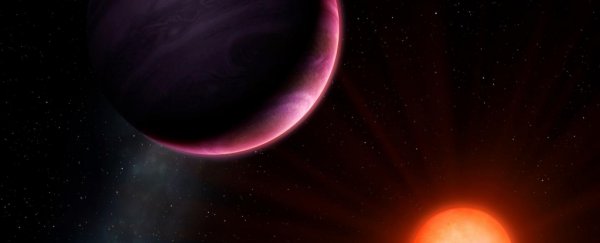Astronomers have found something they thought was impossible: a gas giant roughly the size of Jupiter orbiting a red dwarf half the mass and size of the Sun.
The planet, called NGTS-1b, is a record breaker - the largest planet compared to its star ever found, at a ratio that scientists weren't even sure was possible. This discovery could pose a challenge to our current theories about planetary formation.
"The discovery of NGTS-1b was a complete surprise to us - such massive planets were not thought to exist around such small stars," said lead researcher Daniel Bayliss of the University of Warwick.
"This is the first exoplanet we have found with our new NGTS facility and we are already challenging the received wisdom of how planets form.
"Our challenge is to now find out how common these types of planets are in the galaxy, and with the new NGTS facility we are well-placed to do just that."
Observed using the Next-Generation Transit Survey wide-field telescope array, NGTS-1b is about 600 light-years from Earth. It is what's known as a "hot" Jupiter, a gas giant that is of a similar size to Jupiter but much closer to its host star - therefore hotter, and with a much smaller orbital period.
NGTS-1b has about 20 percent less mass that Jupiter. Current theories about planetary formation don't allow for planets this size to be hanging around so small a star.
Planetary formation usually happens more slowly around small stars, and there's often less material available, so the gas giant in this case is certainly a puzzle.
It also orbits very close to its host star, less than 3 percent of the distance between Earth and the Sun. It completes an orbit in just 2.6 Earth days.
As for the star itself, it's a red M-class dwarf. It's very small, about half the radius and half the mass as the Sun. This means it's still bigger than the planet - Jupiter's radius is about a tenth of that of the Sun, so NGTS-1b's radius would be between a fifth and a quarter of that of its host star, give or take.
But red M-class dwarfs are also the most numerous stars in our galaxy, accounting for around 75 percent of all nearby stars. This is because they don't burn as hot as other stars, and therefore don't deplete their hydrogen as quickly, making them both long-lived and plentiful.
Since the unusually huge planet is paired with such a common star, it means more combinations like this may exist out there. It's possible that we just didn't have the tools to detect them until now.
"NGTS-1b was difficult to find, despite being a monster of a planet, because its parent star is small and faint. Small stars are actually the most common in the Universe, so it is possible that there are many of these giant planets waiting to found," explained researcher Peter Wheatley of the University of Warwick and NGTS lead.
"Having worked for almost a decade to develop the NGTS telescope array, it is thrilling to see it picking out new and unexpected types of planets. I'm looking forward to seeing what other kinds of exciting new planets we can turn up."
The research has been accepted for publication in the peer-reviewed journal Monthly Notices of the Royal Astronomical Society, and can be read online on the pre-print server arXiv.
